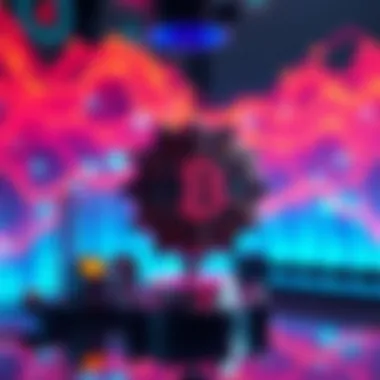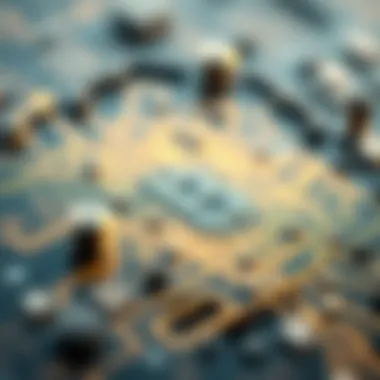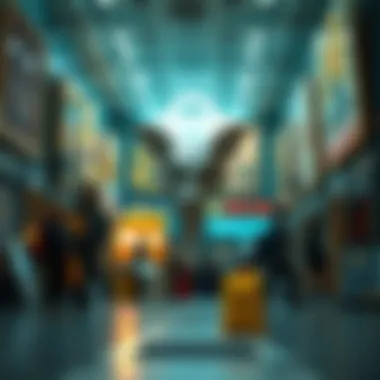Understanding NFT Art Pieces: A Comprehensive Guide


Intro
The digital art world is undergoing a paradigm shift, driven largely by the rise of Non-Fungible Tokens (NFTs). These unique digital assets establish true ownership and authenticity in the online realm, sparking a wave of discussions among investors, collectors, and artists alike. As the democratization of art makes waves, it's essential to grasp the complexities surrounding NFT art pieces and the broader implications they carry.
In this exploration, we will dissect several layers of NFT art, from its evolution and technology to the markets influenced by it. Additionally, we aim to equip you with practical knowledge about how to maneuver the often turbulent waters of NFT investments through sound strategies that account for volatility and risks.
One might ask, "So, what exactly is an NFT, and why should it matter to me?" Well, in an age where digital creations are shared at lightning speed, an NFT serves as a digital certificate of authenticity. It assures buyers that they own the original piece rather than just a copy. Understanding this phenomenon isn’t just for artists and techies; it's crucial for anyone venturing into modern investment landscapes.
Preamble to NFT Art
The world of NFT art has burst onto the scene, carving out a niche that’s hard to ignore. As digital canvases transform into unique, tradable assets, understanding the landscape of NFT art is crucial for anyone interested in art, technology, or investment. This section lays the groundwork for delving deeper into the fascinating domain of non-fungible tokens (NFTs) and their role in the art world.
Defining NFTs
NFTs, or non-fungible tokens, break away from the mold of traditional assets through their ability to represent ownership of unique items on the blockchain. Unlike cryptocurrencies, which are fungible and can be exchanged one-for-one, each NFT has distinct characteristics that define its place in the digital realm. This uniqueness offers artists a way to sell their work as an exclusive item; it’s equivalent to saying, “This piece of art belongs to me, and it’s different from all others.” In practical terms, NFTs often carry metadata that can detail the properties of the digital file, thus ensuring its originality and provenance.
Moreover, the importance of NFTs extends beyond mere ownership. They provide creators—not just artists but musicians, writers, and beyond—a new means to monetize their work directly, cutting out the middlemen traditionally involved in the art market. As such, NFTs hold the capacity to disrupt established norms, reshaping how art is valued and sold.
The Rise of Digital Art
The ascent of digital art has been meteoric, with technology and creativity intersecting in innovative ways. Once dismissed by traditional galleries and critics, digital art has gained recognition and respect in recent years, largely propelled by the introduction of NFTs. Artists can now showcase their work in virtual galleries, reach broader audiences, and, importantly, gain compensation for their digital creations like never before.
Art platforms such as OpenSea and Rarible facilitate the sale of these digital pieces, democratizing access to the art market. This shift is not just a trend; it signifies a vibrant transformation in how we perceive and appreciate art. One might argue that paying for a JPEG seems absurd, yet the cultural implications are profound. As people invest in NFTs, they aren’t merely buying a digital object but are engaging in a new form of cultural currency—a point sharply noted by critics and supporters alike.
In summary, understanding NFT art pieces is about grasping how technology reshapes art ownership and creation. It’s a discussion about value, community, and expression in an era marked by rapid technological advancement. These elements collectively highlight why the conversation around NFT art is not only relevant but necessary for anyone aiming to navigate the intersection of art and technology.
The Mechanism of NFTs
The mechanism behind Non-Fungible Tokens (NFTs) is what sets them apart from traditional collectibles and forms a core component of their significance in the digital art landscape. Without a grasp on how these digital assets operate, it’s easy to miss the impact they have on ownership, authenticity, and the broader financial implications for artists and collectors alike. Understanding this mechanism involves delving into the technical backbone that supports NFTs and the features that make them unique.
How NFTs Work
At its most basic, an NFT functions as a digital certificate of ownership. Unlike cryptocurrency such as Bitcoin, which is fungible (meaning one Bitcoin is the same as another), an NFT is distinct and not interchangeable, making it a perfect fit for art pieces that seek individual recognition. Here’s how it comes together:
- Creation (Minting): Artists create an NFT by minting it on a blockchain, usually Ethereum. During this process, metadata relating to the work (title, description, and a link to the digital file) is recorded.
- Ownership: Once minted, the NFT is assigned to a unique wallet address, indicating the owner. Anyone can view a public ledger of ownership but only the wallet holder has control over the NFT itself.
- Transferability: Ownership can be transferred through secure transactions where the NFT token moves from one wallet to another, akin to passing a physical piece from one person to another.
In summary, NFTs are made to facilitate the ownership of unique digital assets in a way that is clear and verifiable, which is something essential for artists wanting to maintain control over their work in a digital context.
Blockchain Technology Explained
Understanding blockchain technology is essential to grasping how NFTs function. Simply put, a blockchain is a decentralized digital ledger that records transactions across many computers in a way that ensures security and transparency.
- Transparency: Every transaction is visible to anyone with access to the blockchain, which builds trust among users.
- Immutability: Transactions recorded on a blockchain cannot be altered or erased, providing a permanent trace of ownership that is crucial for validating the authenticity of digital art.
- Decentralization: Instead of being controlled by a single entity or platform, blockchain operates via a network of computers, reducing risks associated with central points of failure.
Given these features, blockchain technology underpins the trust and integrity necessary for NFTs to thrive, ensuring that artists can sell their work without fears of forgery or loss of rights.
Smart Contracts and Their Role
Smart contracts are a significant innovation that take the functionality of NFTs a step further. They are self-executing contracts with the terms of the agreement directly coded into lines of software. This allows for:
- Automation: When an NFT is bought or sold, the smart contract can automatically execute terms like royalties for the original artist with each sale. This ensures artists receive compensation over time, which is uncommon in traditional art markets.
- Customization: Artists can customize their smart contracts to include various conditions, such as limits on resale, royalties from future sales, and more.
- Trust: Since buyers don’t have to rely on third-party organizations to enforce contract terms, plays into the decentralization ethos of blockchain.
"Smart contracts change the game by embedding conditions into the NFTs themselves, fostering sustainable models for artist income in the digital realm."
Market Dynamics of NFT Art
Understanding the market dynamics of NFT art is crucial for anyone looking to explore this evolving landscape. This world operates under unique principles driven by technology, consumer behavior, and economic theories. Unlike traditional art markets that rely heavily on galleries and auctions, the NFT art market is decentralized and largely peer-to-peer. This shift has provided both new opportunities and challenges for artists and investors alike.


The explosive growth of NFTs has disrupted many industries, especially how we perceive ownership and value in art. By addressing these fluctuations, investors can position themselves better in a market rife with speculation and change.
Current Trends in the NFT Market
The NFT market has witnessed some fascinating trends that anyone intrigued by digital art should know about. One significant trend is the diversification of content, moving beyond mere images to include music, virtual real estate, and interactive elements.
Another remarkable trend is the rise of fractional ownership of NFTs, which allows multiple investors to own a piece of a high-value NFT. This not only democratizes access but also spreads the risk among many holders.
- The emergence of generative art is hot on the heels of traditional collectibles. Artists use algorithms to create unique pieces, combining tech with creativity in a new way.
- Seasonal events, like holiday-themed NFTs, have surged in sales. Limited-time offers create urgency and can lead to increased demand.
"The unique nature of NFTs allows for innovative expressions of creativity, while also inviting broader public participation in art ownership."
Major Platforms for NFT Trading
In the realm of NFTs, platforms play a pivotal role in how artists and collectors connect. Each of these platforms has unique attributes that cater to various segments of the marketplace.
OpenSea
OpenSea stands as the largest NFT marketplace, a veritable megastore of digital collectibles. Its extensive catalog covers art, domain names, and even virtual pets. The key characteristic of OpenSea is its user-friendly interface that appeals to novices and experienced crypto users alike. It allows anyone to easily mint their own NFTs, thus nurturing an ever-growing pool of digital artists.
One unique feature that OpenSea offers is the ability to create an auction for an NFT; sellers can choose to set a fixed price or let buyers bid. This flexibility can attract different types of investors. The downside, however, is that with so many assets available, discerning value becomes a daunting task for buyers.
Rarible
Rarible has carved a niche in the digital art world due to its community-centric approach, enabling users to vote on platform governance. Its key characteristic is the ability for users to earn RARI tokens through transactions, which gives users a sense of ownership and investment in the platform. Rarible is often favored by artists looking for a more participatory approach.
However, with this emphasis on community participation comes the challenge of maintaining quality control. Not all works may meet the high standards some investors expect, but this democratic stance can also lead to exciting undiscovered talents. This mix makes it a double-edged sword in the NFT marketplace.
SuperRare
SuperRare focuses on the exclusivity of digital art, positioning itself as a high-end platform for collectors seeking unique pieces. The key characteristic of SuperRare is its emphasis on scarcity; every artwork is one-of-a-kind, which appeals to serious collectors wanting to invest in pieces that have a strong potential for appreciation.
The curated nature of SuperRare means there’s a level of quality control that benefits artists who have gained acceptance onto the platform. However, this selectivity can also pose a barrier for emerging artists trying to break into the space. Overall, SuperRare is a haven for art lovers looking for authenticated pieces that hold intrinsic value.
Value Factors in NFT Art
The realm of NFT art is not just a passing fad; it's a fascinating juncture between technology and creativity that has engendered a dialogue about value in the digital age. In this section, we will sift through the various elements that contribute to the value of NFT art, providing insights into how these factors interplay to determine both cultural significance and financial worth. Understanding these factors is essential for artists, collectors, and investors alike, as they navigate this rapidly evolving landscape.
Establishing Value in Digital Art
Establishing the value of digital art forms a complex web of tangibles and intangibles. Unlike traditional art, where value can often be evaluated through physical attributes, the digital sphere presents a unique challenge. Pricing a piece often revolves around market demand, but other aspects come into play.
The initial sales price, the number of times the artwork switches hands, and even the involvement of celebrities or influencers can significantly influence perception and valuation. Additionally, historical context provides a backdrop that may enhance an artwork's value. For instance, look at the Everydays: The First 5000 Days piece by Beeple, which sold for a staggering $69 million at auction. This sale highlighted not only market demand but also the shift towards recognizing digital art as a legitimate form of investment.
In light of this, seasoned investors should consider a blend of market metrics and qualitative judgments when assessing the worth of NFT art pieces.
Rarity and Scarcity
Rarity and scarcity play pivotal roles in determining value in the NFT art space. The digital nature of NFTs complicates traditional notions of scarcity, which have typically relied on physical limitations. Instead, NFTs provide an intriguingly new interpretation of this age-old concept by allowing creators to define digital scarcity through smart contracts.
When an artist decides to mint a limited number of editions for a piece, they establish a controlled supply that influences market dynamics. Rarity isn’t just about numbers, though. It’s also about uniqueness and the distinction between different editions. For example, a one-of-a-kind piece will always carry more weight than a limited series of 100, thus affecting its market value directly.
Further, contextual scarcity enhances desirability. If a piece is tied to a pivotal moment in history or a unique artistic breakthrough, its perceived rarity can skyrocket.
Artist Reputation and Influence
Arguably, the artist's reputation and influence have a profound impact on the value of NFT art. Established artists can command higher prices due to existing fanbases and previously proven work. The digital canvas is no different when it comes to leveraging reputation as a value factor. Emerging artists can also make a mark; however, they often need strategic marketing and community support to achieve visibility.


Furthermore, celebrity collaborations or endorsements can significantly spike interest and, consequently, perceived value. If a well-known figure endorses or buys an NFT from an up-and-coming artist, it can catapult the latter into the limelight, greatly boosting their art's market value.
"Value in art isn’t merely determined by price tags; it is a layered tapestry of culture, context, and community."
For further reading:
Ownership and Authenticity
In the realm of NFT art, the concepts of ownership and authenticity play pivotal roles. Not only do these elements determine the legitimacy of an artwork, but they also influence its market value and the artist's reputation. As digital creations proliferate, ensuring that a piece can be traced back to its rightful owner becomes crucial for artists and collectors alike.
Provenance in the Digital Realm
Provenance refers to the history of ownership of an artwork. In traditional art, this can be a convoluted process, often involving galleries and auction houses. However, in the digital sphere, NFT technology simplifies this record-keeping. Each NFT is encoded with a unique identifier that links it to the original creator, ensuring that collectors can verify the authenticity and ownership of their acquired pieces.
With platforms like OpenSea and SuperRare, buyers can view the complete history of an NFT, from its creation to each subsequent transaction. This transparency builds trust within the community and enhances the collector's confidence in the value of their investment. Moreover, well-documented provenance can significantly increase the desirability of an NFT, making it a hot commodity in the marketplace.
"In the digital art world, the ability to prove ownership via blockchain technology is revolutionary, akin to having a crystal-clear title deed in real estate."
Legal Implications of Ownership
The legal landscape surrounding NFT ownership is still evolving. Unlike physical art, which is generally governed by established laws around copyright and resale rights, NFTs present unique challenges. Buyers need to navigate varying legislation across countries and the complexities of digital contracts. When someone purchases an NFT, they are acquiring certain rights associated with it, but these rights can vary greatly depending on the contract attached to each NFT.
Some key legal aspects include:
- Copyright: Ownership of an NFT does not necessarily grant the buyer copyright over the underlying digital asset. Thus, artists retain their rights unless stated otherwise in the smart contract.
- Resale Rights: Depending on the terms of the contract, creators may or may not receive royalties on secondary sales.
- Fraud and Theft: With the growing number of scams, understanding the legal recourse available in cases of theft or fraud is crucial for NFT owners.
Social and Cultural Impact
The emergence of NFT art has not only transformed the landscape of digital artistry but has also had profound effects on social and cultural dimensions. NFTs, rooted in blockchain technology, have enabled artists to bypass traditional gatekeepers of the art world. This gives remarkable freedom to creators, letting them present their work directly to the audience. This breakthrough is reshaping how art is consumed, distributed, and appreciated.
NFTs and Artistic Expression
NFTs provide an innovative platform for artists to showcase their creativity. Unlike traditional art forms which usually require significant investment in materials or gallery exhibitions, NFTs allow digital artists to express themselves without such barriers. For many artists, especially those in underserved communities, this isn’t just a chance to get noticed but a viable opportunity for financial survival.
Artistic styles and techniques can flourish in this space that may not have gained traction in the physical art world. For instance, artists like Pak and Beeple have significantly expanded the boundaries of artistic expression through NFTs, showcasing works that blend technology and creativity. These platforms enable diverse forms of art, such as generative art, to thrive, breaking the mold of conventional artistic expression.
"NFTs are not simply digital images; they embody the essence of creativity in a format designed to be appreciated and valued in the 21st century."
Additionally, NFTs allow for the creation of interactive and evolving art pieces. Artists can embed features in their NFTs allowing them to morph over time or respond to audience interaction, fundamentally altering how art can be experienced. As such, the artists' stories, struggles, and inspirations are woven into the very fabric of their creations and made accessible to a global audience.
Community Building in the NFT Space
Another significant aspect of NFTs is their role in community building. The digital art and NFT ecosystem is brimming with platforms and social networks that foster connections among artists and collectors alike. Through platforms like Discord and Twitter, communities form around shared interests, facilitating discussions about techniques, trends, and even the principles of ownership and authenticity in digital art.
Collectors and fans interested in the same artists are creating spaces where they can engage, collaborate, and learn from one another. These communities often carry a sense of belonging that goes beyond mere transactions. For example, art collectors are not just purchasing a piece; they are participating in the growth of an artist’s career. This relationship builds a vibrant communication loop between creators and collectors, empowering both sides.
Moreover, many platforms encourage collaboration by allowing artists to drop projects that involve community input. This participatory process ensures that various voices are heard in the creation of art, enhancing the social fabric of the NFT space. As a result, NFT art has become a medium not only for individual expression but also for collective voices, pushing conversations about art into new territories.
In summary, the social and cultural impact of NFTs challenges the norms of traditional art. It unlocks possibilities for artistic expression while fostering vibrant communities where ideas and creativity thrive. The very nature of art is evolving, reflecting the ever-changing landscape of technology and society itself.
For more information on the societal implications of digital art, visit Britannica or explore discussions on Reddit.
Challenges in the NFT Ecosystem
The landscape of NFT art is not without its hurdles. While the allure of digital ownership and groundbreaking creativity captivates many, there are significant challenges that both creators and collectors must navigate. Understanding these issues is essential for making informed decisions in this rapidly evolving sector. From environmental impacts to the unpredictable market dynamics, grasping the challenges enriches one’s comprehension of NFTs and enhances strategic investment potential.


Environmental Concerns
NFTs have garnered attention not only for their innovative nature but also for their environmental repercussions. The technology underpinning most NFTs—blockchain—is energy-intensive. This is particularly true for proof-of-work models, where complex calculations are required to verify transactions. Such processes demand vast computational power, leading to a substantial carbon footprint.
For example, mining for Ethereum, which is widely used for creating NFTs, consumes as much energy as some small countries. The increase in digital art transactions often translates to an insatiable demand for energy. Thus, both artists and collectors may find themselves caught in the crossfire between supporting an ecological future and embracing technological advancement.
A growing number of artists are becoming aware of these impacts and, consequently, are becoming more conscious about their carbon footprints. Some have turned to platforms that prioritize environmentally friendly practices, such as Tezos, which operates on a proof-of-stake model requiring much less energy. This shift shows that while the challenges are significant, potential solutions exist.
"By embracing eco-friendly blockchain alternatives, NFT creators can maintain the same artistic integrity while supporting a greener planet."
Market Volatility and Speculation
The NFT market is as thrilling as it is volatile. Prices can skyrocket overnight, only to plummet just as quickly. Such fluctuations stem from a mix of speculation, hype, and trends. Many collectors have found themselves swept up in the frenzy, purchasing digital art at high prices fueled by the fear of missing out.
Factors contributing to this instability are manifold. News cycles play a pivotal role—when a celebrity jumps into the NFT space, for instance, it can cause a tidal wave of excitement, sending prices soaring. Conversely, negative news or public scrutiny can lead to a rapid downturn, leaving investors checking their portfolios in disbelief.
Consider the case of Beeple, whose work sold for $69 million at auction, which sent shockwaves across the art world. This transaction, while historic, also raised eyebrows, sparking discourse about real value versus speculative pricing. Investors might find themselves grappling with whether an NFT’s price is justified long-term or merely a fleeting moment of trending interest.
Navigating this unpredictable terrain requires a keen eye and a level-headed outlook. For those committed to collecting and investing in NFTs, thorough research and a clear strategy can be invaluable. Identifying emerging trends, assessing artist credibility, and keeping abreast of technological advancements may help minimize risk in this fast-paced environment.
The road ahead for NFT enthusiasts may be fraught with challenges, but it also holds plenty of potential for in-depth understanding and responsible investing. By recognizing and addressing issues like environmental impact and market volatility, participants can contribute to a healthier NFT ecosystem.
Future Outlook for NFT Art
The future of NFT art is not just a fleeting whisper in the winds of technology but rather a profound movement that is gaining ground. As we explore this terrain, it’s clear that understanding the trajectory of NFT art is crucial for investors, artists, and technologists alike. The confluence of creativity and blockchain technology presents a myriad of opportunities that can reshape the art world as we know it. There is a rich tapestry of innovation being woven, drawing together various threads of creativity, culture, and commerce.
One cannot overlook the pivotal role that predictions and forecasts play in guiding those who navigate this landscape. As interest in digital ownership burgeons, astute observers of the market must consider factors such as potential market growth and advancements that may emerge on the horizon. By analyzing these prospects, collectors and creators can position themselves strategically to harness the potential of NFT art.
Predictions for Market Growth
The size of the NFT market has shown wild fluctuations, much akin to the volatile nature of cryptocurrencies. According to some analysts, the NFT market could grow significantly, driven by the rising acceptance of digital assets and the allure of ownership that blockchain affords.
While the exact growth percentage is up for debate, key indicators suggest that:
- Mainstream Acceptance: As major brands and celebrities familiarize themselves with NFTs, there is an increasing likelihood of mainstream adoption.
- Diverse Use Cases: Beyond art, sectors like music, fashion, and gaming are continuously experimenting with NFT integration, which may attract even more investors and creators.
- Improved Platforms: User-friendly NFT marketplaces like OpenSea, Rarible, and others will streamline buying and selling experiences, making the space more accessible.
These factors together indicate a promising horizon, but they are not without their challenges. As much as growth seems imminent, caution must also be exercised due to market volatility.
Innovations on the Horizon
The potential for innovation in the NFT realm can’t be overstated. The landscape is changing rapidly, and several trends are bubbling to the surface:
- Dynamic NFTs: Imagine NFTs that can evolve over time based on certain criteria—changing visuals or unlocking new content as the owner interacts with them. This could shift the way art is viewed and experienced.
- Fractional Ownership: This would allow multiple people to own a piece of high-value art, democratizing access and fostering a broader appreciation for pieces that were once only in the realms of the elite.
- Interoperability: A key innovation may be the ability for NFTs to be utilized across different platforms, creating a cohesive ecosystem where assets can flow freely, enriching user experience.
"The shift towards digital ownership marks a new dawn, where art meets innovation in ways we've only begun to explore."
End
Concluding the exploration of NFT art pieces brings us to recognize their far-reaching implications in today’s digital age. This article has dissected numerous aspects, revealing how NFTs are not simply a renewed means of artistic expression but also a shift in ownership and economic dynamics within the artistic community.
Summarizing Key Points
Let’s look back at the key takeaways that can aid investors, traders, and enthusiasts:
- NFT Definition and Rise: NFTs allow for ownership and provenance of digital artworks, driving the popularity of digital art as a legitimate market.
- Mechanics of NFTs: We discussed how NFTs leverage blockchain to establish uniqueness, eliminate counterfeit issues, and enable smart contracts that enforce ownership rights automatically.
- Market Trends: The growing interest in platforms like OpenSea and Rarible showcases a shift towards niche markets as they cater to diverse artists and collectors.
- Valuation Factors: As established, rarity, artist reputation, and market sentiment play pivotal roles in determining the value of any NFT.
- Ownership and Legality: Understanding the legal framework surrounding NFT ownership is essential to navigate potential pitfalls, especially concerning copyright and usage rights.
- Social Implications: Beyond economics, NFTs are altering how communities form around shared interests and values in art, giving rise to a new kind of social interaction.
In summary, grasping these points equips stakeholders with the knowledge required to navigate and thrive in the evolving landscape of NFT art.
Final Thoughts on NFT Art
Looking ahead, it is clear that NFT art pieces exemplify a crossover between technology and creativity unlike anything seen before. They are game changers, shaking up traditional art markets and pushing boundaries for what is possible in both artistic and business avenues. As markets continue to evolve, it's vital for artists and collectors alike to stay informed and adaptable. The road is filled with uncertainties, but the excitement of potential innovation in this interface is undeniable.
"The future of art is not found in just colors and canvases, but in pixels and protocols that redefine ownership itself."
In the coming years, one could argue that the true measure of success will not just be the monetary value of NFT art but rather the meaningful connections formed within communities around these digital creations. With ongoing developments and innovations, the journey of understanding and engaging with NFT art is just beginning.















